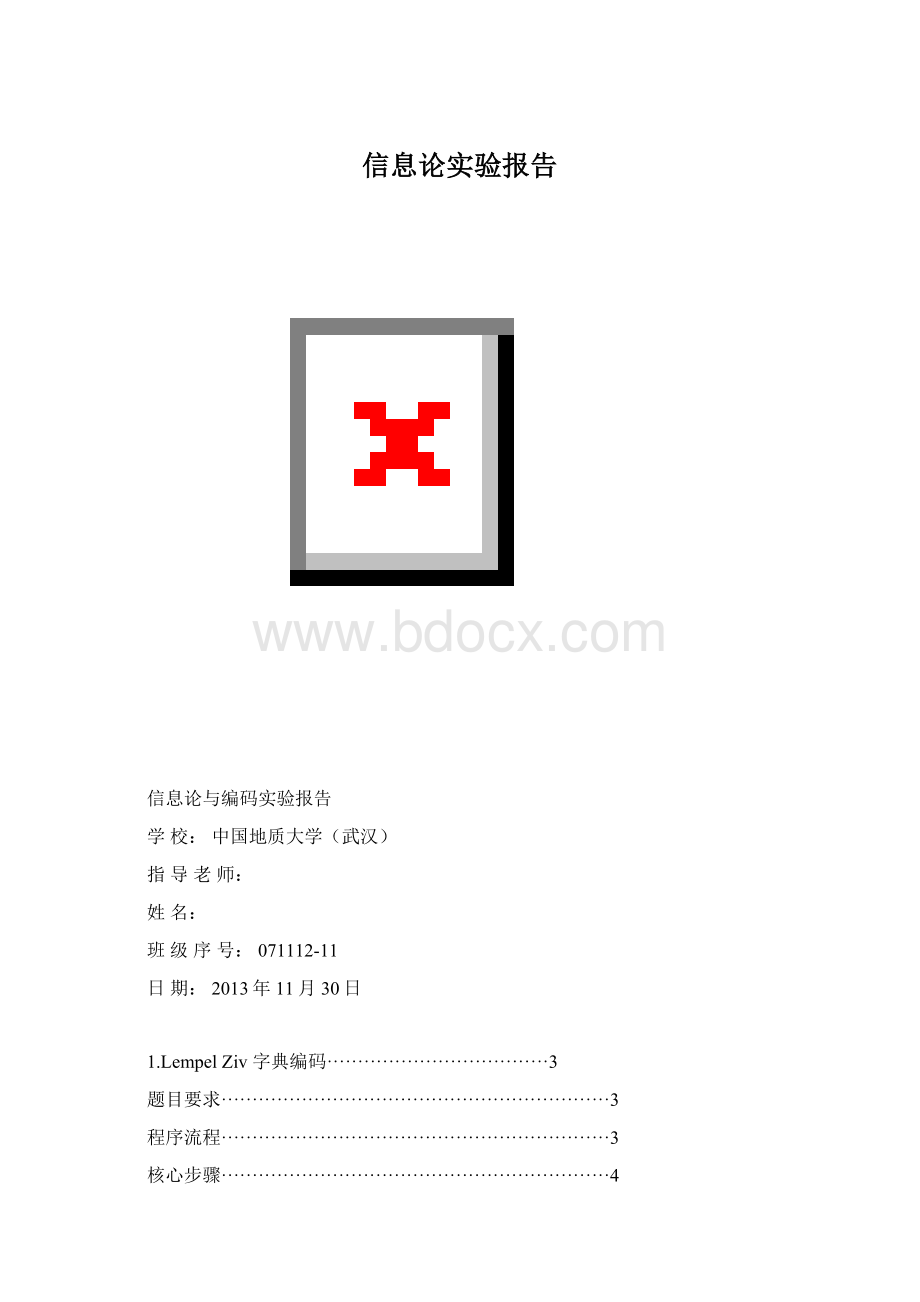信息论实验报告.docx
《信息论实验报告.docx》由会员分享,可在线阅读,更多相关《信息论实验报告.docx(39页珍藏版)》请在冰豆网上搜索。

信息论实验报告
信息论与编码实验报告
学校:
中国地质大学(武汉)
指导老师:
姓名:
班级序号:
071112-11
日期:
2013年11月30日
1.LempelZiv字典编码····································3
题目要求·······························································3
程序流程·······························································3
核心步骤·······························································4
程序代码·······························································5
测试结果·······························································9
效果分析及改进建议····················································11
2.信道容量计算···········································12
题目要求·······························································12
程序流程·······························································12
核心步骤·······························································13
程序代码·······························································13
测试结果·······························································13
效果分析·······························································14
3.汉明码的编码与解码····································14
题目要求·······························································14
程序流程·······························································14
核心步骤·······························································15
程序代码·······························································15
测试结果·······························································18
效果分析及改进建议·····················································19
4.循环码的生成与最小距离计算····························19
题目要求·······························································19
程序流程·······························································19
核心步骤·······························································20
程序代码·······························································20
测试结果·······························································23
效果分析·······························································23
5.卷积码的编码与解码····································24
题目要求·······························································24
程序流程·······························································25
核心步骤·······························································25
程序代码·······························································25
测试结果·······························································31
效果分析及改进建议·····················································32
6.上机总结···············································33
1.LempelZiv字典编码
题目要求
WriteaprogramthatexecutestheLempelZivalgorithm.TheinputtotheprogramcanbetheEnglishalphabets.ItshouldconvertthealphabetstotheirASCIIcodeandthenperformthecompressionroutine.Itshouldoutputthecompressionachieved.Usingthisprogram,findoutthecompressionachievedforthefollowingstringsofletters.
(i)TheLempelZivalgorithmcancompresstheEnglishtextbyaboutfiftyfivepercent.
(ii)Thecatcannotsitonthecanopyofthecar.
程序流程
1.编码算法:
N
Y
2.解码算法与编码恰好相反(略):
核心步骤
1.构造字典,初始字典中应包含1-256所有ASIIC码对应的字符;
2.分清字典编号和字符的关系:
编码时始终对字符和字符串进行操作,但发送的始终是对应的字典编号。
解码时始终对字典编号进行操作,但输出的是编号对应字符。
3.编写相关函数,实现对字典的基本操作,如:
添加新字符、字符串拼接、查找某个编号对应的字符、查找某个字符串对应的编号;
4.在字典中添加,Newchar:
,Link...,以便对字典进行操作
程序代码
1.构建字典:
function[new_dic]=Creat_newdic()
%构建初始字典
%使用说明:
%new_dic=Creat_newdic();
new_dic=zeros(512,30);
new_dic=uint8(new_dic);
fori=1:
256
new_dic(i,1)=i;
end
new_dic=char(new_dic);
new_dic(257,1:
8)='Newchar:
';
new_dic(258,1:
7)='Link...';
end
2.向字典里添加新字符串:
function[dic_out,flag]=Add_newstr(dic_in,newstr)
%向字典添加新字符串
%使用方法
%[dic_out,flag]=Add_newstr(dic_in,newstr)
dic_out=dic_in;
L=size(newstr);
flag=1;
position=Search_str(dic_in,'Link...');
ifposition==512
flag=0;return;
end
dic_out(position,:
)=0;
dic_out(position,1:
L
(2))=newstr;
dic_out(position+1,1:
7)='Link...';
end
3.取出字典里某个位置的字符串:
function[str]=Get_str(dic,position)
%取出某字典中的指定位置的字符串
%使用说明:
%str=Get_str(dic,position);
%L=size(dic(position,:
));
fori=1:
30
if(dic(position,i)~=0)
N=i;
else
break;
end
end
str(1:
N)=dic(position,1:
N);
end
4.在指定的字典里查找某个字符串:
function[position]=Search_str(dic,str)
%在字典中查找某字符串
[M,N]=size(str);
position=0;
fori=1:
512
ifdic(i,1:
N)==str
position=i;
break;
end
end
end
5.将两个字符串相加:
function[position]=Search_str(dic,str)
%在字典中查找某字符串
[M,N]=size(str);
position=0;
fori=1:
512
ifdic(i,1:
N)==str
position=i;
break;
end
end
end
6.编码过程:
function[code_out,dic_out]=LZ_coding(dic_in,str)
%字典编码之发送端
%Detailedexplanationgoeshere
dic_out=dic_in;
[M,N]=size(str);
counter=1;
ifN==0
code_out(counter)=Search_str(dic_out,'Newchar:
');
counter=counter+1;
code_out(counter)=Search_str(dic_out,'Link...');
retu